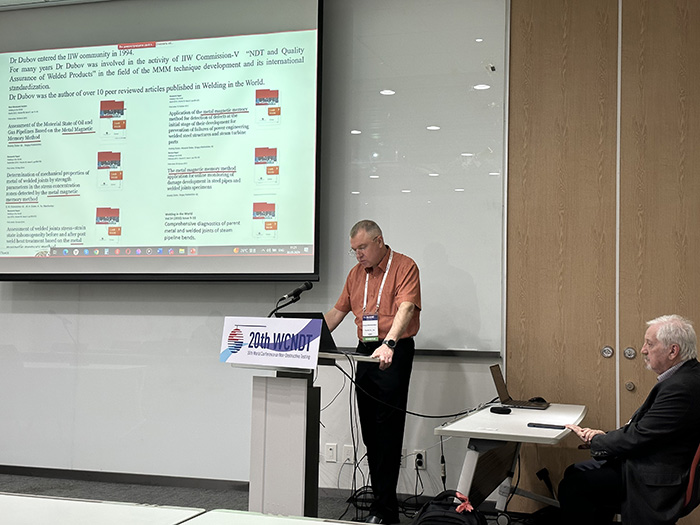May 31, 2024
Specialist International Group on the Metal Magnetic Memory Method of the International Committee for Non-Destructive Testing (ICNDT SIG MMM)
The Specialists International Group on the Metal Magnetic Memory method of the International Committee for Non-Destructive Testing (ICNDT SIG MMM) began its work in 2018 within the framework of ICNDT WG3 “Education and Research”. The group is chaired by Mr. P. Ladanyi and supported by the Hungarian Non-Destructive Testing Association (MAROVISZ, Budapest).
The fourth meeting of the ICNDT SIG MMM was held on May 30, 2024 within the framework of the 20th World Conference on Non-Destructive Testing (20th WCNDT) in Incheon, Republic of Korea.
The ICNDT SIG MMM meeting was attended by 21 specialists from 9 countries: Argentina, Brazil, Canada, China, Czech Republic, Hungary, Korea, Malaysia and Russia.
At the meeting, reports were delivered on the following topics:
- Report on the work of the ICNDT SIG MMM for 2018 – 2023.
- Work Plan of the ICNDT SIG MMM for 2024 – 2025.
- How MMM can be integrated with other pipeline integrity technologies.
- Advances in MMM Using Drones and Augmented Reality.

During the period from 2018 to 2023, within the framework of the activities of the ICNDT Specialists International Group on the MMM method, the following work and activities were carried out:
- Two international conferences on the MMM method were organized on April 24-25, 2018, in Budapest and on May 22-23, 2019, in Prague.
- Specialists of the group took part in 18 international and national NDT conferences by making reports on the topic “Practical application of the MMM method”.
- The International Scientific and Technical online Conference “Diagnostics of equipment and structures using the MMM method” was held in February 2021. More than 170 specialists from different countries took part in the conference: Argentina, Belarus, Brazil, Bulgaria, China, Czech Republic, Hungary, Japan, Iran, Kazakhstan, Korea, Lithuania, Malaysia, Moldova, Poland, Saudi Arabia, UAE and Ukraine.
- Within the framework of IIW and ISO/TC 44 standardization committees, a new revision of international standards was prepared and put into effect: ISO 24497-1:2020(E) Non-destructive testing – Metal magnetic memory – Part 1: Vocabulary and general requirements, and ISO 24497-2:2020(Е) Non-destructive testing – Metal magnetic memory – Part 2: Inspection of welded joints.
- More than 25 were published in international technical journals, in particular: “Diagnostics of power boiler superheater tubes made of austenitic steel using the metal magnetic memory technique” in the “Welding in the World” journal, the authors A.Dubov, Al. Dubov, S. Kolokolnikov, A. Marchenkov; “Experimental substantiation of diagnostic parameters used in metal magnetic memory method” in the “Insight” journal, the authors A. Dubov, Al. Dubov, P. Ladanyi, A. Marchenkov, S. Kolokolnikov. Professor Shi Pengpeng from China prepared a survey paper on the results of laboratory and industrial studies of efficiency of the MMM method application in China and other countries. The review is based on 256 published articles over the past 20 years in well-known technical journals in China, Europe, and America.
- The book “Metal magnetic memory method. Purpose and practical capabilities" was published under the general editorship of A.A. Dubov in Russian and English. The book was written in collaboration with the following specialists: P. Ladanyi, P. Trampus (Hungary), E. Gorokhov (Argentina), V. Svoboda (Czech Republic), Mohd Nur Bahorin (Malaysia).
- Training and certification in the MMM method were conducted: in Russia – more than 740 specialists, in China – 49 specialists, in Malaysia – 31 specialists and 88 specialists in other countries (Argentina, Azerbaijan, Belarus, Brazil, Canada, Czech Republic, India, Kazakhstan, Korea, Lithuania, Moldova, Mongolia, Poland, Saudi Arabia, Slovakia, Switzerland, UAE). In total, as of the end of 2023, about 4,000 specialists in Russia and more than 1,000 specialists in other countries were certified.
As of January 2024, the MMM method has been spread to 47 countries of the world.
The ICNDT SIG MMM continues to work actively in accordance with the Work Plan for 2024 – 2025, which includes the following activities:
1. Participation in the exhibition and 20th World Conference on Non-Destructive Testing (20th WCNDT), Incheon, Korea, May 27-31, 2024.
2. Participation in national and international conferences on non-destructive testing with reports on the experience of the MMM method application in technical diagnostics of equipment and structures, in particular:
- 11th international industrial forum “NDT Territory”, Moscow, Russia, April 15-17, 2024;
- World Congress on Condition Monitoring (3rd WCCM), Beijing, China, October 15-18, 2024;
- 24th international exhibition "NDT Russia", Moscow, Russia, October 22-24, 2024;
- 34th Annual Conference & Exhibition on Non-Destructive Evaluation & Enabling Technologies, Chennai, India, December 12-14, 2024;
- 12th international industrial forum “NDT Territory”, Moscow, Russia, April 14-16, 2025.
At the ICNDT SIG MMM meeting, it was proposed to discuss with the Malayan NDT Society the possibility of holding the fourth international conference on the MMM method in Malaysia.
3. Harmonization of the MMM method with technical supervision bodies and national authorities.
4. Promotion and coordination of experimental studies of metals' physical and mechanical properties using the MMM method.
5. NDT personnel training and certification in the MMM method in Russia, Kazakhstan, China, Malaysia, India, Moldova, Croatia, Azerbaijan and other countries.
6. Publication of articles in national and international scientific and technical journals, including "Welding in the World" and "Insight" journals.
7. Further development of the non-contact method, development of procedures for inspection of various equipment.
At the ICNDT SIG MMM meeting, a resolution was adopted to develop ICNDT recommendations for application of non-contact magnetometric inspection of buried pipelines based on the metal magnetic memory method.